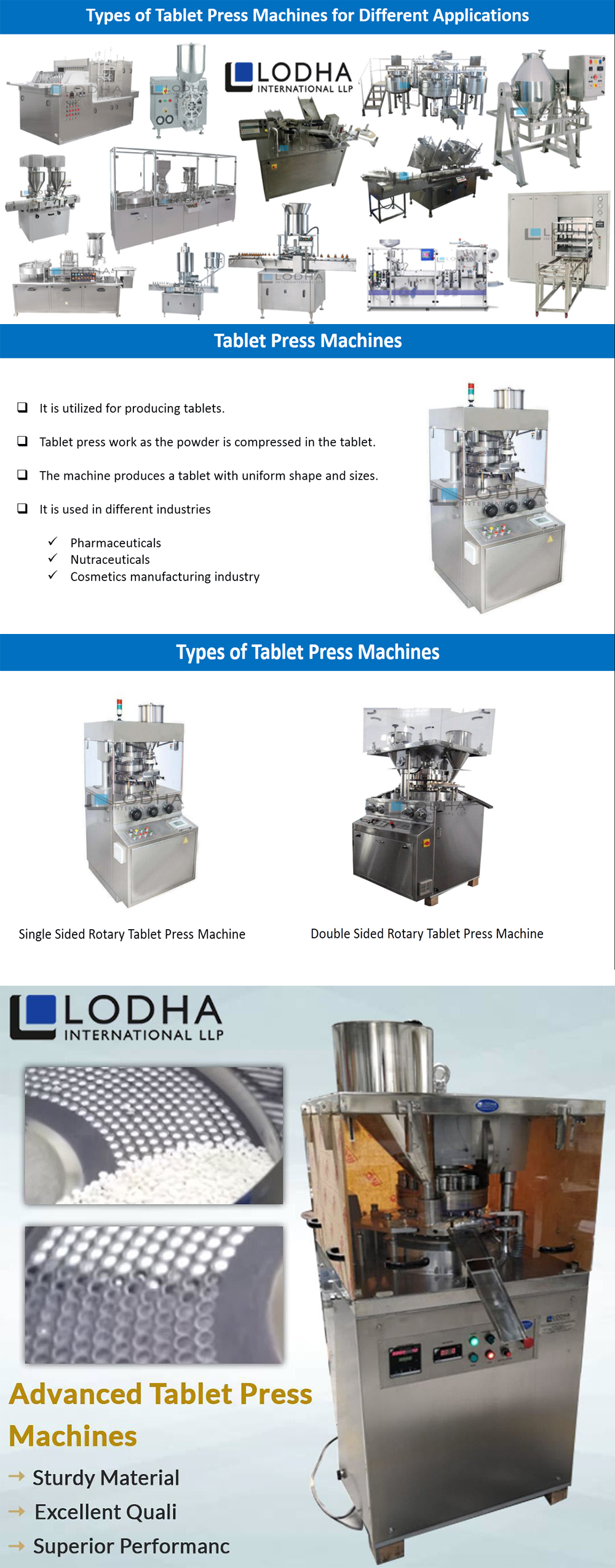Get in touch! +91 9687731331 | +91 9687631331 | info@lodhapharma.com
An Overview on Tablet Presses & their Tooling Systems
There are many types of tablet presses available on the market. Before purchasing a tablet press, however, it is important to understand the basics of the machine. Here are the different types and the benefits associated with each. Listed below are some of the most popular types:
Working of Tablet Press Machine
A tablet press machine works by compressing the raw materials in a die cavity with a predetermined level of force. When the tablet is fully formed, it will be expelled from the die cavity and swept into the chute container. Then the upper punch is drawn back down, and a pull-down cam returns the lower punch to its lowest position.
The main compression rollers apply a set amount of force to the dies, thereby ensuring consistency in the tablet thickness. The rotary tablet press uses gears and belts to transfer motion. A semi-automatic lubrication system is located at the bottom of the machine, which minimizes oil contamination and build-up of heat. The lubrication system ensures a smooth operation and minimal component wear.
Rotary Tablet Press Machine
A rotary tablet press is a type of tablet making machine. This type of machine produces thick and thin tablets in various sizes, shapes, and hardness. The optimum distance between the compression rollers depends on the hardness and thickness of the tablet being produced. The weight of the tablet also needs to be maintained, so that the tablet is compressed and ejected properly. A rotary tablet press has several stages, including the ejection phase, which involves the removal of the tablet from the punch-die station at the bottom. It is then moved up to a turret, where the top punch draws the tablet up.
The compression unit of a rotary tablet press includes a housing, which contains various components. The housing is divided into three sections: the lower section, designated drive section, and the central compression unit. Each of the three sections is separated by a partition wall, and each section has a valve for the feedstock.

Round Shaped Tooling System in Tablet Press Machine
The round shaped tooling system in a tablet press machine comprises an upper punch, lower punch and die. During compression, the upper punch makes the upper cavity in the tablet, which is then filled with the granules or powder. The lower punch has no key and is longer than the other punch tips. This helps achieve consistency in the thickness of the tablets.
The tooling for the tablet press machine plays a crucial role in creating the final product. The tooling of the tablet press machine controls the shape and size of the finished product. The tools consist of an upper and lower punch as well as dies. They must comply with strict uniformity, aesthetic and production efficiency guidelines.
BB Tooling in Tablet Press Machine
BB tooling for tablet press machines consists of various tools, including dies that come in different sizes. The punches are driven into the die cavity by upper and lower cams that move up and down. This tooling helps in filling the die cavity and pushing the tablets out through the discharge chute. These devices can be directly attached to the tablet press machine or separately used. Both are essential for the production of tablets.
The die system tooling is the main component of a tablet press machine. It is responsible for aligning the punches and dies for optimal compression. The dies are positioned on a cam track, which guides the lower punch upward and downward during the filling stage. The lower punch moves along a cam track which assists in accurate adjustment. When the tablet is completed, it will be discharged through the die cavity.
The Bottom Line
A tablet press machine can produce high volumes of tablets quickly and efficiently, and also produce a variety of shapes and sizes of tablets. It also features a high utilization ratio, making it a good choice for production. Tablet Press Machine is equipped with high pressure to minimize weight variations and maintain a low noise level.
Tablet press machine is highly accurate and efficient at using raw materials, and can produce different size tablets. Unlike older styles of tablet presses, these presses have electronic adjustments for precise pressure control. In addition, their large power reserves allow them to maintain high production rates without sacrificing quality.


